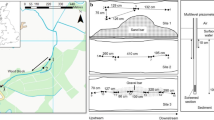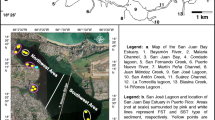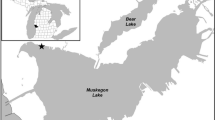Abstract
This study examined how sediment-sorbed PCBs and several large storms affected sediment nutrient dynamics based on potential nitrification rates and benthic flux measurements. PCBs were hypothesized to negatively affect potential nitrification rates due to the sensitivity of nitrifying bacteria. Sediment disturbance caused by the succession of storms, which can enhance nutrient inputs and phytoplankton production, was hypothesized to enhance both potential nitrification rates and benthic flux measurements as a result of higher nutrient and organic matter concentrations. Potential nitrification rates, benthic fluxes (NO3 − + NO2 −, NH4 +, and DIP), sediment PCB content, water content, organic content, salinity, bottom water dissolved oxygen, and sediment chlorophyll were measured at 13 different sites in Escambia Bay during the summer of 2005. Potential nitrification rates were highest at deep, organic-rich sites. Total PCB content did not have a direct effect on potential nitrification rates. An analysis of recent changes in benthic processes in relation to extreme meteorological events was performed by comparing the 2005 results with data from 2000, 2003, and 2004. Storm effects on sediment biogeochemistry were mixed with sediment nitrogen dynamics enhanced at some sites but not others. In addition, SOC and NH4 + fluxes increased in deeper channel sites after Hurricanes Ivan and Dennis, which could be attributed to the deposition of phytoplankton blooms. Sediment nutrient dynamics in Escambia Bay appear to be resilient to these extreme meteorological events since there were no significant effects on sediment processes in the Bay as a whole.







Similar content being viewed by others
References
Ammerman, J., 2003. Determination of Orthophosphate by Flow Injection Analysis. QuikChem Method 31-115-01-1-I for Lachat Instruments, Milwaukee, WI.
ATSDR (Agency for Toxic Substances and Disease Registry), 1995. Toxicological Profile for Polychlorinated Biphenyls. Draft for Public Comment (Update). Prepared by Research Triangle Institute, under Contract No. 205-93-0606 for ATSDR, Public Health Service, U.S. Department of Health and Human Services.
Blackburn, T. H., 1988. Benthic mineralization and bacterial production. In Blackburn, T. H. & J. Sorensen (eds), Nitrogen Cycling in Marine Sediments. Wiley, New York: 175–190.
Boström, B., J. M. Andersen, S. Fleischer & M. Jansson, 1988. Exchange of phosphorous across the sediment-water interface. Hydrobiologia 170: 229–244.
Burkholder, J. M., 1998. Implication of harmful microalgae and heterotrophic dinoflagellates in management of sustainable marine fisheries. Ecological Applications 8: S37–S62.
Caffrey, J. M. & W. M. Kemp, 1990. Nitrogen cycling in sediments with estuarine populations of Potamogeton perfoliatus and Zostera marina. Marine Ecological Progress Series 66: 147–160.
Caffrey, J. M., N. P. Sloth, H. F. Kaspar & T. H. Blackburn, 1993. Effects of organic loading on nitrification and denitrification in a marine sediment microcosm. FEMS Microbiology Ecology 12: 159–167.
Caffrey, J. M., D. E. Hammond, J. S. Kuwabara, L. G. Miller & R. R. Twilley, 1996. Benthic processes in South San Francisco Bay: the role of organic inputs and bioturbation. In Hollibaugh, J. T. (ed.), San Francisco Bay: The Ecosystem. Pacific Division/American Association for the Advancement of Science, San Francisco: 425–442.
Caffrey, J. M., N. E. Harrington, I. Solem & B. B. Ward, 2003. Biogeochemical processes in a small California Estuary: 2. nitrification activity, community structure and role in nitrogen budgets. Marine Ecology Progress Series 248: 27–40.
Campos, J. L., J. M. Garrido, R. Mendez & J. M. Lema, 2001. Effect of two broad-spectrum antibiotics on activity and stability of continuous nitrifying system. Applied Biochemistry and Biotechnology 95: 1–10.
Canfield, D. E., B. Thamdrup & E. Kristensen, 2005. Aquatic geomicrobiology. Elsevier Academic Press, London.
Caraco, N. F., J. J. Cole & G. E. Likens, 1989. Evidence for sulphate-controlled phosphorus release from sediments of aquatic systems. Nature 341: 316–318.
Cowan, J. L. W., J. R. Pennock & W. R. Boynton, 1996. Seasonal and interannual patterns of sediment-water nutrient and oxygen fluxes in Mobile Bay, Alabama (USA): regulating factors and ecological significance. Marine Ecology Progress Series 141: 229–245.
Diamond, D. H., 2003. Determination of Nitrate in Brackish or Seawater by Flow Injection Analysis. QuikChem Method 31-107-04-1-A for Lachat Instruments, Milwaukee, WI.
Diaz, R. J. & R. Rosenberg, 1995. Marine benthic hypoxia: a review of the ecological effects on the behavioural responses of benthic macrofauna. Oceanography and Marine Biology. Annual Review 33: 245–303.
DiDonato, G. T., E. M. Lores, M. C. Murrell, L. S. Smith & J. M. Caffrey, 2006. Benthic nutrient flux in a small estuary in northwestern Florida (USA). Gulf and Caribbean Research 18: 15–25.
Duke, T. W., J. I. Lowe & A. J. Wilson Jr., 1970. A polychlorinated biphenyl (Aroclor® 1254) in the water, sediment, and biota of Escambia Bay, Florida. Bulletin of Environmental Contamination and Toxicology 5: 171.
Dušek, L., 1995. Activity of nitrifying populations in grassland soil polluted by polychlorinated biphenyls (PCBs). Plant and Soil 176: 273–282.
Finstein, M. S. & M. R. Bitsky, 1972. Relationship of autotrophic ammonium-oxidizing bacteria to marine salts. Water Resources 6: 31–40.
Fogel, M. L., C. Aguilar, R. Cuhel, D. J. Hollander, J. D. Willey & H. W. Paerl, 1999. Biological and isotopic changes in coastal waters induced by Hurricane Gordon. Limnology and Oceanography 44: 1359–1369.
Folk, R. L., 1974. Petrology of Sedimentary Rocks. Hempell’s, Austin, TX.
Friedrich, J., C. Dinkel, G. Friedl, N. Pimenov, J. Wijsman, M. T. Gomoiu, A. Cociasu, L. Popa & B. Wehrli, 2002. Benthic nutrient cycling and diagenetic pathways in the North-western Black Sea. Estuarine Coastal Shelf Science 54: 369–383.
Goreau, T. J., W. A. Kaplan, S. C. Wofsy, M. B. McElroy, F. W. Valois & S. W. Watson, 1980. Production of NO2 − and N2O by nitrifying bacteria at reduced concentrations of oxygen. Applied and Environmental Microbiology 40: 526–532.
Hagy III, J. D. & M. C. Murrell, 2007. Susceptibility of a Gulf of Mexico estuary to hypoxia: an analysis using box models. Estuarine, Coastal and Shelf Science 74: 239–253.
Hagy III, J. D., J. C. Lehrter & M. C. Murrell, 2006. Effects of Hurricane Ivan on water quality in Pensacola Bay, FL, USA. Estuaries and Coasts 29: 919–925.
Hall, P. O. J., L. G. Andersson, M. M. Rutgers van der Loeff, B. Sundby & S. F. G. Westerlund, 1989. Oxygen uptake kinetics in the benthic boundary layer of sediments. Limnology and Oceanography 34: 734–736.
Hansen, J. I., 1980. Potential Nitrification in Marine Sediments. M.Sc. Thesis, University of Aarhus, Denmark.
Helder, W. & R. T. P. de Vries, 1983. Estuarine nitrite maxima and nitrifying bacteria (Ems-Dollard Estuary). Netherlands Journal of Sea Research 17: 1–18.
Henriksen, K., 1980. Measurement of in situ rates of nitrification in sediment. Microbiology Ecology 6: 329–337.
Henriksen, K. & W. M. Kemp, 1988. Nitrification in estuarine and coastal marine sediments. In Blackburn, T. H. & J. Sørensen (eds), Nitrogen cycling in coastal marine environments. Wiley, Chichester: 207–249.
Henriksen, K., J. I. Hansen & T. H. Blackburn, 1981. Rates of nitrification, distribution of nitrifying bacteria, and nitrate fluxes in different types of sediment from Danish waters. Marine Biology 61: 299–304.
Henriksen, K., M. B. Rasmussen & A. Jensen, 1983. Effect of bioturbation on microbial nitrogen transformations in the sediment and fluxes of ammonium and nitrate to the overlying water. Ecological Bulletin 35: 193–205.
Henriksen, K., T. H. Blackburn, B. A. Lomstein & C. P. McRoy, 1993. Rates of nitrification, distribution of nitrifying bacteria and inorganic N fluxes in the northern Bering-Chukchi shelf sediments. Continental Shelf Research 13: 629–651.
Herbert, R. A., 1999. Nitrogen cycling in coastal marine ecosystems. FEMS Microbiology Review 23: 563–590.
Holmes, R. M., A. Aminot, R. Kerouel, B. A. Hooker & B. J. Peterson, 1999. A simple and precise method for measuring ammonium in marine and freshwater ecosystems. Canadian Journal of Fisheries and Aquatic Sciences 56: 1801–1808.
Jaynes, M. L. & S. R. Carpenter, 1986. Effects of vascular and nonvascular macrophytes on sediment redox and solute dynamics. Ecology 67: 875–882.
Jensen, H. S. & F. Ø. Andersen, 1992. Importance of temperature, nitrate, and pH for phosphate release from anaerobic sediments of 4 shallow, eutrophic lakes. Limnology and Oceanography 37: 577–589.
Jensen, M. H., E. Lomstein & J. Sørensen, 1990. Benthic NH4 + and NO3 − flux following sedimentation of a spring phytoplankton bloom in Aarhus Bight, Denmark. Marine Ecological Progress Series 61: 87–96.
Jensen, H. S., P. B. Mortensen, F. Ø. Andersen, E. Rasmussen & A. Jensen, 1995. Phosphorous cycling in a coastal marine sediment, Aarhus Bay, Denmark. Limnology and Oceanography 40: 908–917.
Jones, R. D. & M. A. Hood, 1980. Effects of temperature, pH, salinity and inorganic nitrogen on the rate of ammonium oxidation by nitrifiers isolated from wetland environments. Microbiology Ecology 6: 339–347.
Kemp, W. M., R. L. Wetzel, W. R. Boynton, C. F. D’Elia & J. C. Stevenson, 1982. Nitrogen cycling in estuarine interfaces. In Kennedy, V. S. (ed.), Estuarine Comparisons. Academic Press, New York: 209–230.
Kemp, W. M., P. Sampou, J. Caffrey, M. Mayer, K. Henriksen & W. R. Boynton, 1990. Ammonium recycling versus denitrification in Chesapeake Bay sediments. Limnology and Oceanography 35: 1545–1563.
Kennish, M. J., 1992. Ecology of Estuaries: Anthropogenic Effects. CRC Press, Boca Raton, Florida.
Keppler, C. J., J. Hoguet, K. Smith, A. H. Ringwood & A. J. Lewitus, 2005. Sublethal effects of the toxic alga Heterosigma akashiwo on the southeastern oyster (Crassostrea virginica). Harmful Algae 4: 275–285.
Landsberg, J. H., 2002. The effects of harmful algal blooms on aquatic organisms. Source Reviews in Fisheries Science 10: 113–390.
Liao, N., 2003. Determination of Ammonia in Brackish or Seawater by Flow Injection Analysis. Quickchem Method 31-107-06-1-B for Lachat Instruments, Milwaukee, WI.
Livingston, R. J., 1999. Ecology and trophic organization, in Pensacola Bay System environmental study, section 5A. Unpublished report from Champion International Corporation: 1–125.
Lohse, L., J. F. P. Maschaert, C. P. Slomp, W. Helder & W. van Raaphorst, 1993. Nitrogen cycling in North Sea sediments: interaction of denitrification and nitrification in offshore and coastal areas. Marine Ecology Progress Series 101: 283–296.
MacFarlene, G. T. & R. A. Herbert, 1984. Effect of oxygen tension, salinity, temperature, and organic matter concentration on the growth and nitrifying activity of an estuarine strain of Nitrosomonas. FEMS Microbiology Letters 23: 107–111.
Mallin, M. A., M. H. Posey, G. C. Shank, M. R. McIver, S. H. Ensign & T. D. Alphin, 1999. Hurricane effects on water quality and benthos in the Cape Fear watershed: natural and anthropogenic impacts. Ecological Applications 9: 350–362.
Maruya, K. A., B. G. Loganathan, K. Kannan, S. McCumber-Kahn & R. F. Lee, 1997. Organic and organometallic compounds in estuarine sediments from the Gulf of Mexico (1993–1994). Estuaries 20: 700–709.
Meehl, G. A., T. F. Stocker, W. D. Collins, P. Friedlingstein, A. T. Gaye, J. M. Gregory, A. Kitoh, R. Knutti, J. M. Murphy, A. Noda, S. C. B. Raper, G. Watterson, A. J. Weaver & Z. C. Zhao, 2007. Global climate projections. In Solomon, S., D. Qin, M. Manning, Z. Chen, M. Marquis, K. B. Averyt, M. Tignor & H. L. Miller (eds), Climate Change 2007: The Physical Science Basis. Contribution of Working Group I to the Fourth Assessment Report of the Intergovernmental Panel on Climate Change. Cambridge University Press, Cambridge, United Kingdom and New York, NY, USA.
Miller, J. L., M. A. Sardo, T. L. Thompson & R. M. Miller, 1996. Effect of application solvents on heterotrophic and nitrifying populations in soil microcosms. Journal of Environmental Toxicology and Chemistry 16: 447–451.
Murrell, M. C., R. S. Stanley, E. M. Lores, G. T. Didonato, L. M. Smith & D. A. Flemer, 2002. Evidence that phosphorus limits phytoplankton growth in a Gulf of Mexico Estuary: Pensacola Bay, Florida, USA. Bulletin of Marine Science 70: 155–167.
Murrell, M. C., J. Campbell, J. D. Hagy III & J. M. Caffrey, 2009. Effects of irradiance on benthic and water column processes in a Gulf of Mexico estuary: Pensacola Bay, Florida, USA. Estuarine Coastal and Shelf Science. doi:10.1016/j.ecss.2008.12.002.
National Oceanic and Atmospheric Administration (NOAA). Public communication (a). http://weather.noaa.gov/weather/current/KPNS.html.
National Oceanic and Atmospheric Administration (NOAA). Public communication (b). http://response.restoration.noaa.gov/book_shelf/122_squirt_cards.pdf.
National Research Council, 2000. Clean Coastal Waters: Understanding and Reducing the Effects of Nutrient Pollution. National Academy Press, Washington, DC.
Niencheski, L. F. & R. A. Jahnke, 2002. Benthic respiration and inorganic nutrient fluxes in the estuarine region of Patos Lagoon (Brazil). Aquatic Geochemistry 8: 135–152.
Nijhof, M. & J. Bovendeur, 1990. Fixed film nitrification characteristics in sea-water recirculation fish culture systems. Aquaculture 87: 133–143. doi:10.1016/0044-8486(90)90270-W.
Nimmo, D. R., R. R. Blackman, A. J. Wilson Jr. & J. Forester, 1971. Toxicity and distribution of Aroclor® 1254 in the pink shrimp Paneaeus duorarum. Marine Biology 11: 191. doi:10.1007/BF00401266.
Nimmo, D. R., D. J. Hansen, J. A. Couch, N. R. Cooley, P. R. Parrish & J. I. Lowe, 1975. Toxicity of Aroclor®1254 and its physiological activity in several estuarine organisms. Environmental Contamination and Toxicology 3: 22–39.
Olsson, M., B. Karlsson & E. Ahnland, 1992. Seals and seal protection: a presentation of a Swedish research project. Ambio 21: 494–496.
Olsson, M., B. Karlsson & E. Ahnland, 1994. Diseases and environmental contaminants in seals from the Baltic and Swedish west coast. Science of the Total Environment 154: 217–227.
Paerl, H. W., J. D. Bales, L. W. Ausley, C. P. Buzzelli, L. B. Crowder, L. A. Eby, J. M. Fear, M. Go, B. J. Peierls, T. L. Richardson & J. S. Ramus, 2001. Ecosystem impacts of three sequential hurricanes (Dennis, Floyd, and Irene) on the United States’ largest lagoonal estuary, Pamlico Sound, NC. Proceedings of the National Academy of Sciences 98: 5655–5660.
Parsons, T. R., Y. Maita & C. M. Lalli, 1984. A Manual of Chemical and Biological Methods for Seawater Analysis. Pergamon Press, Oxford.
Ripl, W., 1976. Biochemical oxidation of polluted lake sediment with nitrate—a new lake restoration method. Ambio 3: 132–135.
Risgaard-Petersen, N., 2003. Coupled nitrification-denitrification in autotrophic and heterotrophic estuarine sediments: on the influence of benthic microalgae. Limnology and Oceanography 48: 93–105.
Risgaard-Petersen, N., R. L. Meyer & N. P. Revsbech, 2005. Denitrification and anaerobic ammonium oxidation in sediments: effects of microphtyobenthos and NO3 −. Aquatic Microbial Ecology 40: 67–76.
Rysgaard, P., T. Thastum, T. Dalsgaard, P. B. Christensen & N. P. Sloth, 1999. Effects of salinity on NH4 + adsorption capacity, nitrification, and denitrification in Danish estuarine sediments. Estuaries 22: 21–30.
Sayler, G. S., M. P. Shiaris, W. Beck & S. Held, 1982. Effects of polychlorinated biphenyls and environmental biotransformation products on aquatic nitrification. Applied and Environmental Microbiology 43: 949–952.
Seitzinger, S. P., 1988. Denitrification in freshwater and coastal marine ecosystems: ecological and geochemical significance. Limnology and Oceanography 33: 702–724.
Seitzinger, S. P., S. W. Nixon & M. E. Q. Pilson, 1984. Denitrification and nitrous oxide production in a coastal marine ecosystem. Limnology and Oceanography 29: 73–83.
Shumway, S. E., H. P. van Egmond, J. W. Hurst & L. L. Bean, 1995. Management of shellfish resources. In Hallengraeff, G. M., D. M. Anderson & A. Cambella (eds), Manual on Harmful Marine Microalgae. UNESCO, Paris: 433–461.
Smith, K., 2006. Effects of Salinity on Potential Nitrification. Masters Thesis, University of West Florida.
Smolders, A. J. P., L. P. M. Lamers, M. Moonen, K. Zwaga & J. G. M. Roelofs, 2001. Controlling phosphate release from phosphate-enriched sediments by adding various iron compounds. Biogeochemistry 54: 219–228.
Thorpe, P., R. Bartel, P. Ryan, K. Albertson, T. Pratt & D. Cairns, 1997. The Pensacola Bay System Surface Water Improvement and Management Plan: A Comprehensive Plan for the Restoration and Preservation of the Pensacola Bay System. Program Development Series 97-2. Northwest Florida Water Management District, Havana.
Tobias, C., A. Giblin, J. McClelland, J. Tucker & B. Peterson, 2003. Sediment DIN fluxes and prefential recycling of benthic microalgal nitrogen in a shallow macrotidal estuary. Marine Ecology Progress Series 257: 25–36.
Twilley, R. R., J. Cowan, T. Miller-Way, P. A. Montagna & B. Mortazavi, 1999. Benthic nutrient fluxes in selected estuaries in the Gulf of Mexico. In Bianchi, T. S., J. R. Pennock & R. R. Twilley (eds), Biogeochemistry of Gulf of Mexico Estuaries. Wiley, New York, NY, USA: 163–209.
USAF (U.S. Air Force), 1989. The Installation Restoration Program Toxicology Guide, Vol. 3. Aerospace Medical Division, Air Force Systems Command, Wright-Patterson Air Force Base, Ohio: 52-1–52-68.
U.S. Environmental Protection Agency (USEPA), 1999. Method 1668, revision A: chlorinated biphenyl congeners in water, soil, sediment, and tissue by HRGC/HRMS. EPA No. EPA-821-R-00-002.
U.S. Environmental Protection Agency (USEPA), 2004. The Ecological Condition of the Pensacola Bay System, Northwest Florida (1994–2001). U.S. Environmental Protection Agency, Office of Research and Development, National Health and Ecological Effects Research Laboratory, Gulf Ecology Division, Gulf Breeze, Florida.
Vitousek, P. M., J. D. Aber, R. W. Howarth, G. E. Likens, P. A. Matson, D. W. Schindler, W. H. Schlesinger & D. G. Tilman, 1997. Human alteration of the global nitrogen cycle: Sources and consequences. Ecological Applications 7: 737–750.
Voytek, M. A. & B. B. Ward, 1995. Detection of ammonia-oxidizing bacteria of the beta-subclass of the class proteobacteria in aquatic samples with the PCR. Applied and Environmental Microbiology 61: 2811.
Welschmeyer, N. A., 1994. Fluorometric analysis of chlorophyll-a in the presence of chlorophyll-b and phaeopigments. Limnology and Oceanography 39: 1985–1992.
Wilson, A. J. & J. Forester, 1978. Persistence of Aroclor® 1254 in a contaminated estuary. Environmental Contamination and Toxicology 19: 637–640.
Zaranke, D. T., R. W. Griffiths & N. K. Kaushik, 1997. Biomagnification of polychlorinated biphenyls through a riverine food web. Environmental Toxicology and Chemistry 16: 1463–1471.
Acknowledgements
This work was funded by a National Science Foundation grant (OCE-0352221) to J. M. Caffrey. We thank R. Snyder, W. Jeffrey, R. Deveraux, M. Murrell, C. Mohrherr, T. Martin, M. Wagner, E. Gaige, and A. Ren for their field and lab assistance. We thank M. Lewis, M. Murrell, and two anonymous reviewers for comments on an earlier version of this manuscript. We also thank University of West Florida Marine Services and the University of West Florida Wetlands Research Laboratory for their assistance.
Author information
Authors and Affiliations
Corresponding author
Additional information
Handling editor: P. Viaroli
Rights and permissions
About this article
Cite this article
Smith, K.A., Caffrey, J.M. The effects of human activities and extreme meteorological events on sediment nitrogen dynamics in an urban estuary, Escambia Bay, Florida, USA. Hydrobiologia 627, 67–85 (2009). https://doi.org/10.1007/s10750-009-9716-x
Received:
Revised:
Accepted:
Published:
Issue Date:
DOI: https://doi.org/10.1007/s10750-009-9716-x




